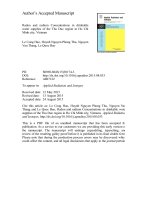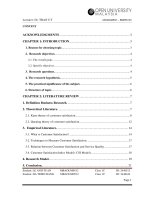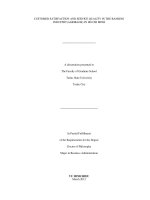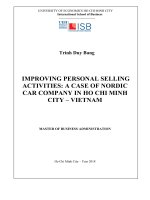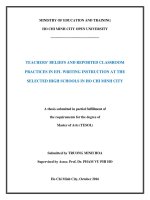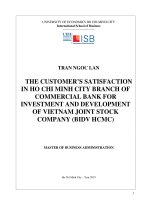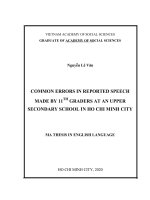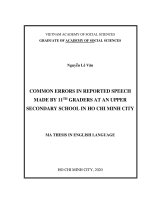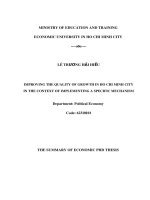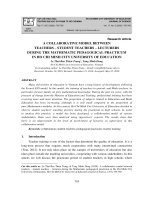Improving teaching staff recruitment efficiency at the transportation iii college in ho chi minh city
Bạn đang xem bản rút gọn của tài liệu. Xem và tải ngay bản đầy đủ của tài liệu tại đây (710.3 KB, 47 trang )
MEIHO UNIVERSITY
Graduate Institute of Business and Management
MASTERS THESIS
Improving Teaching Staff Recruitment
Efficiency at the Transportation III College
in Ho Chi Minh City
In partial fulfillment of the requirements for the degree of
Masters of Business Administration
Advisor: Dr. Ron Chuen Yeh
Co-advisor: Dr. Nguyen Van Hoa
Graduate Student: Ngo Thi Kim Oanh
December, 2010
ACKNOWLEDGMENTS
Firstly, I wish to express my profound gratitude to my supervisor Dr. Ron Chuen
Yeh, and Dr. Nguyen Van Hoa for their sound advices and whole-hearted guidance for
the development and completion of this study.
I am further indebted to the cooperation of College teachers who have participated
in the research, especially those who attended in-depth interviews with me. I also want to
sincerely thank all my professors, officials and fellows of the Graduate Institute of
Business and Management at Meiho University in the process of research and study in
Taiwan, where I learned academic knowledge and Taiwanese culture. Special thanks to
all my friends for their continuous encouragement.
I am also grateful to my professors at Vietnam and my classmates in the EMBA 2
together to share knowledge in the learning process. Finally, I would like to thank all
members of my family for their love and encouragement for hanging in there until the end.
I
Improving Teaching Staff Recruitment Efficiency
at the Transportation III College
in Ho Chi Minh City
ABSTRACT
The recruitment process of teachers potentially affects the quality of education
delivered to students. Thus, recruitment in educational institutions is very important. The
aim of this research is to determine the factors most important in influencing the
recruitment process at Transportation III College in Ho Chi Minh City. Interviews with
experienced human resource staffs were done at all the colleges in the Ho Chi Minh City
area in order to find the most efficient and appropriate recruitment processes. Also, a
survey was done on all the teaching staff of the Transportation III College to see what
they thought about the most important factors in recruitment. The research findings
concluded that in order to boost the quality of teaching in colleges at Transportation III
College, greater attention needs to go towards improving the reward system, working
environment and self development opportunities.
Keywords: Recruitment, Human Resources, Compensations, Training & Promotion,
Working Environment, Teaching Quality
II
Improving Teaching Staff Recruitment Efficiency
at the Transportation III College
in Ho Chi Minh City
Contents
ACKNOWLEDGMENTS ......................................................................................................... I
ABSTRACT..............................................................................................................................II
Contents .................................................................................................................................. III
Tables....................................................................................................................................... V
Figures..................................................................................................................................... VI
Chapter1 Introduction ............................................................................................................... 1
1.1 Background and Motivation ........................................................................................... 1
1.2 Case College Description................................................................................................ 3
1.3 Research Purposes and Research Questions................................................................... 4
1.4 Definition of Terms ........................................................................................................ 7
1.4.1 Recruitment.............................................................................................................. 7
1.4.2 Teaching quality. ..................................................................................................... 9
Chapter 2 Literature Review................................................................................................... 10
2.1 Human Resource Management in School..................................................................... 10
2.2 Factors Influencing Recruitment. ................................................................................. 12
2.3 Recruitment and Teaching Quality ............................................................................... 14
Chapter 3 Research Methodology........................................................................................... 17
3.1 Research Procedure....................................................................................................... 17
3.2 Research Methods......................................................................................................... 18
3.3 Sampling ....................................................................................................................... 19
3.4 Interviewing Information and Questions ...................................................................... 20
3.4.1 The detail information of interviewed Persons...................................................... 20
3.4.2 Interviewing questions. .......................................................................................... 22
3.4.3 Questionnaire use to ask teachers in College Transportation III. .......................... 22
3.5 Validity and Reliability................................................................................................. 23
3.6 Data Collection ............................................................................................................. 25
Chapter 4 Research Results and Analysis............................................................................... 26
4.1 Descriptive Statistics..................................................................................................... 26
III
4.2 Pearson Correlation....................................................................................................... 27
4.3 Regression Analysis...................................................................................................... 28
Chapter 5 Implications, Conclusions and Recommendations................................................. 31
5.1 Conclusions................................................................................................................... 31
5.2 Suggestions ................................................................................................................... 31
References............................................................................................................................... 34
Attachment.............................................................................................................................. 36
IV
Tables
Table 3-1 Interviewed Person ............................................................................................20
Table 3-2 Cronbach’s for Research Variables ...................................................................24
Table 4-1 Descriptive Statistics .........................................................................................26
Table 4-2: Correlation Matrix (n = 91)a .............................................................................27
Table 4-3 Regression Analysis (1).....................................................................................28
Table4-4 Regression Analysis (2)......................................................................................29
Table 4-5 Summary of Results on Hypotheses..................................................................30
V
Figures
Figure 2-1 Research Framework........................................................................................16
Figure 3-1 Research Process Flow.....................................................................................18
VI
Improving Teaching Staff Recruitment
Efficiency at the Transportation III
College in Ho Chi Minh City
Chapter1 Introduction
1.1 Background and Motivation
After more than two decades of development, Vietnam’s economy has gained
remarkable achievements. Yet it still does not meet the practical requirements of society,
especially in the context that region has been growing rapidly. There is still a widen gap
between Vietnam and first world countries. To shorten the distance, Vietnam has
identified education and training as the most important national policy to serve the
industrialization and modernization of the country.
As Vietnam enters the process of industrialization and modernization, many
countries have passed this era and are coming into the information age, building
economic and social knowledge. The gap in the level of economy, science and technology
between Vietnam and other developed countries continue to increase, with Vietnam even
falling behind some developing countries in the South East Asia region. One important
reason is because of the intellectual quality, creative ability and technical skills that have
not been updated. The World Economic Forum (WEF) in 2005 ranked the quality of
educated workers in Vietnam as 53rd of 59 countries surveyed. The Human Development
Report of the United Nations (UNDP: united nations development programme) evaluated
Vietnam’s education system as lagging behind China by 10 years, Thailand by 15 years,
Malaysia by 20 years, Korea by 25 years, Singapore by 35 years and Japan by 40 years.
The knowledge revolution presents challenges with the process of globalization and
international integration, especially as Vietnam has officially become the 150th member
of the World Trade Organization (WTO). The lag in scientific technology is not a
problem unique to Vietnam. Therefore, there is a driving force to develop technology, and
foreign investment is encouraged as it imports higher technology into the country.
In the face of this demand, quality of educated workers is matters of interest to
social and economic development. The advancement of technology requires businesses to
quickly retrain their technical staff. These are issues that need to be trained earlier in the
1
universities and colleges so graduates can immediately integrate with workplace
requirements and avoid re-training making a loss for businesses and society.
Currently, there are 9 colleges training workers into the private sector. In particular,
Ho Chi Minh City has 5 colleges in the teaching in the area of transportation, including 3
vocational colleges. College Transport III located in Ho Chi Minh City is a key school in
this field. It is the only college where the graduates have an opportunity to continue into
university. The remaining two colleges are the affiliated units of the transport industry.
College Transportation III has over 33 years experience in professional secondary
education and workforce practice, including more than 10 years of teaching college-level
bachelor degrees. Recently it has implemented a training model in 4 levels: Workers,
secondary, colleges and universities (alternative university entry).
The continuous training and development of teaching staff is important. Teaching
staff have a crucial role in accomplishing tasks and ensure the teaching standards of the
school. The school has invested many years in its teaching staff, facilities and equipment
to create an environment of effective teaching and learning. Its curriculum is based on the
Ministry of Education and Training program, combined with practical training and
technology application.
In the past decade, low teaching quality was epidemic in Vietnamese college
schools. The low quality teaching environment is caused by some problems, such as low
salary, ineffective hiring procedures, and poorly updated teaching material. Besides that,
there were no directives in the school’s policy to encourage teachers to attend academic
conferences for absorbing new knowledge and teaching skills. The phenomenon of low
teaching quality in Vietnamese college schools has attracted the attention of principals in
those colleges, who want to improve the situation. As a teacher of one such college, the
mentioned low teaching quality stirs the motivation of this research that investigates the
human resource management of school and its possible relationship with the teaching
quality. For improving teaching quality, recruitment is a very important issue in colleges
of Vietnam, especially in a rapidly changing education environment in universities around
the world.
According to latest statistics by the Ministry of Education, the country has 325
universities, colleges, the other educational institutes (25 of which have been established
in the past year). Number of students nationwide is now 1.4 million but there are only
about 52,000 teachers. Thus, the percentage of teacher / student is 1 / 28; while in other
countries are 1 / 15 or 1 / 20. In private universities and colleges, an excessive amount of
2
students are accepted for profit making, while too few teachers are trained leading to a
teacher / student ratio of 1/30. For example, the University of Commerce, the average
number of teaching hours per year of a teacher is 422 hours (approximately 162% in
excess of regular hours).(Dantri.com.vn, 2009).
The Deputy Minister of Education and Training Banh Tien Long admitted: Number
of university teachers currently meets only 60% of actual demand, because many
universities and colleges have been opened. These new places enroll the students but do
not have adequate teaching faculties, administrative staff. Teachers, particularly, spend
too many hours in teaching and spend not much time for scientific research, preparation
of teaching material, so the quality of teacher development is very limited.
(Dantri.com.vn, 2009).
There are 38,217 university teachers in 2009, an average increase of 14.20% per
year. The rate is 30.89 per student / faculty, but some cases this rate is still higher than 50
students / faculty members. Even with the economic bloc that number is 100 students /
teachers (Dantri.com.vn, 2009). Actually, College Transport III is high at the rate of
student / faculty ratio compared with other colleges, which was one of the causes
affecting the quality of teaching
1.2 Case College Description
The case school - College Transport III - is a public institution ruled by the
Ministry of Transport in Vietnam. The school has 170 full time teachers who belong to 12
departments: Construction of road and bridges, civil and industrial construction,
technology of construction materials, Business Accounting, Banking and Finance,
Engineering Construction Management, Business Management, basic subjects, Mining
and Transport, Automotive Engineering, metal cutting, Telecommunication and Network
Management.
Now the case school has over 5,000 students. The mission statements of the school
are being a college with multi, interdisciplinary fields in transport; with functions and
tasks in scientific research; implementation of programs, projects, research projects and
scientific application and technological transfer; cooperation, joint venture, association
with other national and international organizations; providing resources for the
industrialization - modernization, service requirements of economic and social
development in the South, Central Highland regions in particular and the country in
general in the context of global economic integration. The mission of the case school, the
3
school makes effort to chase the following educational goals: Building a school that trains
human resources qualities, competitive in the economy of the country; operating under
ISO 9001 Quality Management; increasing joint training with local and foreign
prestigious training institutions to diversify the type and quality of training; focusing on
the program to enhance financial resources; increasing investment in facilities and
teaching staff; upgrading to the training school at university on the basis of college traffic
Transport III.
In fact many schools to open new branches, the percentage of students to teachers
is too high compared with provisions to the exchange of feedback between faculty and
students is limited, teachers just can lecture, cannot know the learning of students
Besides the reputation of the college, teachers do not keep up with demand in
quantity and quality, owing to teachers have to teach too many hours and have not much
time left for scientific research to improve their qualification and quality of teaching.
Furthermore, this region lacks teachers. Therefore, leading to the recruitment of teachers
for college transport III is much difficult.
As we know, recruiting teacher is an important task because it decides the
development of the school in future. A right recruitment strategy is a very important to
avoid problems with teachers. Although many teachers lack, most school still do not
attractive to recruit teachers. For the case school, it also lacks effective teaching staff,
which may be caused by the low salary and the work environment. Therefore, a good
recruitment policy should be settled, otherwise recruitment of teachers will be extremely
difficult.
1.3 Research Purposes and Research Questions
Education and Training has a separate set of bearing great responsibility for
training human resources in all areas of the country. People working in any industry
depend heavily on knowledge, experience and skills they received during their learning.
Education and training have a great influence on the quality components of the overall
human resources such as physical factors, intellectual and moral qualities. Although
laborers from the learning environment came out real work is influenced more from the
working environment as well as social factors, but can not deny the fundamental role of
education and training in improving experience, as well as skills needed for health
workers can undertake the job.
4
Education and Training in general is the basis of human resources development, is
the way to uphold basic human resources. Special importance of education expressed as a
driving force in economic development and social. A socio-economic wanted to develop
the strength needed to generate the level of intellectual age and level of intelligence
sources and technical personnel sufficient to produce innovation and improve
productivity activities, development of service activities, cultural, spiritual, this depends
on education, needs highly qualified human resources in the economy. People are
educated and self-education is considered the most important factor, just the motivation,
is both the goal of sustainable development of society. Well-educated man can solve
problems creatively and effectively because of the social set.
Strategic objectives to develop human resources of Vietnam are to meet the
industrialization and modernization of the country to our country in 2020 to basically
become an industrialized country. Ninth Congress of the Party has guided the
development of human resources in Vietnam: "The employee has a high intellect, skill
proficiency, good quality, training and development fostered by an advanced education is
associated with a scientific background, modern technology ".
Vocational Education and Training is a key component to create human resources
of technical qualifications and professional skills for the industrialization and
modernization of the country. Education and Training focus primarily on the development
team of faculty, build, strengthen and expand infrastructure, equipment for schools,
complete management system, enabling the school to increase scale and ensure quality
training. 2005 education law has clearly defined the priorities of the State for teachers of
colleges and universities: "The teacher of colleges and universities are employed by the
method of preference for students graduated with good, excellent, good quality and who
have a university degree, master degree, doctoral degree, experienced practitioners, who
wish to become teachers. Before being assigned to teach, teachers of colleges and
universities must be trained in pedagogical". This shows that human resources for
teachers of colleges and universities are state interests. Therefore, they are constantly
being recruited. In addition to facilitate improvement of professional skills is worthy of
human resources with highest level of education. All of these contribute to shoulder the
responsibility of training human resources for the country
Education and Training is recognized as an effective tool for developing human
resources with high qualifications and social development in many ways. Education and
Training is the source of human resources including personnel management, scientific
5
research, faculty, service personnel are taught to teach, impart knowledge, new
technology or contribute science for the instruction and training. They are the main
contributors to the education and training to ensure quality. To ensure quality output is
highly qualified human resources. Low-quality teaching cannot expect social output
quality human resources. We can say, along with human resources at all educational
levels, other education, education and training affect the quality of training of human
resources of the country in general
To improve the quality of teaching, knowledge and practical application,
recruitment being used to solve the problem of teaching quality may exist. Therefore, the
purposes of this study are:
(1) Examine the existing teaching staff recruitment practice at case college.
(2) Suggest an appropriate teaching staff recruitment model for case college.
With the above research purpose, this search proposes the research questions
bellow:
(1) What is the common teaching staff recruitment model of colleges in Ho Chi Minh
City?
(2) What is the most appropriate teaching staff recruitment model of colleges in Ho Chi
Minh City?
(3) What is the existing teaching staff recruitment model of the case college?
(4) What are the strength and weakness of the existing teaching staff recruitment model
of the case college?
(5) What is the best model of teaching staff recruitment for the case college?
Because practice training and development, compensation benefits, working
environment, relationship between colleagues and the school's recruitment policy can
improve the quality of faculty teaching in colleges of Vietnam.
To improve the quality of teaching, knowledge and practical application,
recruitment was used to solve the problem of teaching quality. Therefore, the purposes of
this study also try to find a correlation between recruitment and teaching quality, and
answer the following questions:
(1) What is the regime of training and development of schools related to recruitment and
teaching quality?
(2) What is compensation regime of preferential treatment of schools associated with
recruitment and teaching quality?
6
(3) What is the work environment of the school's field related to recruitment and teaching
quality?
(4) What is the relationship between colleagues of the school related to recruitment and
teaching quality?
(5) Is recruitment policy of the school now effective?
1.4 Definition of Terms
1.4.1 Recruitment.
The recruitment in this research includes following concepts and their related
description.
1.4.1.1 Requirement of human resources trained quality.
Faculty and staff for education are to teach the students or contacts, handling work
related to students in the learning process at universities. Because of this, as well as in
other educational levels of the education sector, the qualities and skills characteristic of
human in trained will not affect the formation of qualities and skills of the staff of BA
engineer, high quality human resources of the entire society. Considering the quality
requirements, specific skills of staff working in universities, especially faculty, Edwin
Rosinski, professor at the University of California has launched a research specific
research in 2003 included a set of skills and qualities required of human resources trained
quality. Thesis would be cited a number of specific requirements as follow:
(1) Ability to present a clear, concise and logical
(2) There are easy-listening voice
(3) Having a good vocabulary
(4) Know how to use the equipment for teaching lesson
(5) There is good pedagogy, making teaching more attractive and easier to understand
(6) Calm, said to receive criticism with a constructive attitudes
(7) Ability to maintain appropriate speed lectures with qualified students
(8) Always try to understand more than the knowledge can be found in textbooks
(9) Always try to connect teaching with practical
(10) Always have the enthusiasm for the job, job requirements, dedicated
(11) Set specific goals for students
(12) Ability to feel good psychological
(13) Have appropriate clothing for the environment breaking, looks confident,
comfortable
7
(14) Friendly, sympathetic attitude toward students, avoid imposing their own views,
expressed the attitude of respect and concern for students
(15) Ability to research and quickly adapt to changes
(16) With progressive attitude, the desire to learn from their students and from other
sources about the effectiveness of teaching
The qualities and skills as mentioned above are the most basic requirements for
human resources in trained. Also, new requirements may be added depending on social
and cultural factors. “Research by Professor Michael is a valuable reference for those
universities in the process of building standards in teacher recruitment, administration and
improving teaching and learning in schools. (Michael, 2002)."
1.4.1.2 The concept and tasks of teachers.
Trainers are qualified teachers undertake the task of teaching and training in
higher education, colleges of a specialized training for universities, colleges. The
specific tasks of the faculty include:
(1) Teaching is part of the curriculum or curriculum subjects are assigned, participate
and guide the evaluation period dissertation, thesis, or graduate from university
colleges.
(2) Write lecture notes, compiled reference subjects assigned to undertake
(3) Participation in scientific research, primarily at the department or school
(4) Implement fully the provisions on professional expertise and under the statutes of
the University
(5) Participate in management training (if required, head of the class and direct
practice
1.4.1.3 Some Criteria for Evaluation of Qualifications and Competence of
Teachers
(1) Education
(2) Foreign language, computer science
(3) Ability to pedagogical
(4) Experience teaching
(5) Research Ability
Above is the most important criteria in the selection process and evaluation of
teaching staff, the Education Law also clearly preferred universities recruit graduate
students excellent type, well, there qualities and who holds a university degree or higher,
have experience of good practices to supplement the teaching staff. Standard university
8
quality assessment by the Ministry of Education and Training issued stating requirements
for teaching staff should be guaranteed the standard qualifications of teachers trained
according to regulations. Specifically, the required qualifications are as follows: Teachers:
Having a college degree or more, have passed the probationary period under the current
regulations and have at least two graduate certificate training. Senior Lecturer: Having a
master's degree or higher, have worked in the faculty ranks at least 9 years, was a foreign
language use in professional degree C.
Senior Lecturer: a Ph.D. degree of specialized training, a senior lecturer at the rank
of at least 6 years, using the two foreign languages to serve the teaching, research and
international communication (first foreign language equivalent to level C, 2 foreign
languages at secondary level B), have at least 3 projects or scientific works created by the
Council of Science recognized universities or industry and introduced effective. Other
criteria such as teaching skills, management ability or knowledge other than the
assessment of credentials, qualifications are also assessed through methods such as
collecting opinions contingent of students, trainees, colleagues, managers, and so on.
1.4.2 Teaching quality.
Teaching quality is related to materials, tools, instruments, and processes of
teaching. High teaching quality can be produced from efficiently employing teaching
tools, materials, instruments in appropriate processes (Elam, Scales & Pearson, 2009).
High teaching quality will improve learning effectiveness of students in the one hand. On
the other hand, high teaching quality will lead to job satisfaction which will increase
commitment to the organization (Dunrong & Fan, 2009). For discussing the teaching
quality of teacher, this study thus focuses on teacher’s perspective.
Regarding to the evaluation of teaching quality, the ways include self evaluation of
teacher and evaluated by students with a questionnaire (Elam, Scales & Pearson, 2009).
9
Chapter 2 Literature Review
Based on previous and comparative literature, this study can meticulously and fully
understand more about Human Resource Management especially on recruitment in school
and Teaching Quality. This chapter provides a comprehensive overview of these contents.
In this study, some recent literature of human resource management especially on
recruitment in school and teaching quality are reviewed. Following the literature review,
the research hypothesis is developed and built accordingly
2.1 Human Resource Management in School
Prior literature has seldom discussed the human resource management in school.
However, this research searches and reviews some of recent literature related to this
subject.
From a performance-based perspective to discuss human resource management
approach in business schools, Lorange (2006) examines the professorial human resource
base in academic institutions. Specifically, he focuses on professors in business schools.
His research finds that all academic institutions, including business schools, must have
top-quality faculty. Because they drive for enhancing academic value creation, generating
cutting-edge research, leading teaching, building strong interrelationships with students
and fueling the success of the academic institution.
Lorange (2006) concludes that a performance-based human resources policy is
linked to the overall strategy for professors in academic institutions, particularly business
schools. This strategy is likely to be more focused on an eclectic, “we, we, we”
approach—in contrast to traditional axiomatic thinking. That is, a human resources policy
along these lines would benefit from the dissolution of academic departments, the
abolition of academic title hierarchy, and even the abandonment of tenure. He have
advocated a performance-based bonus system for each faculty member and suggested
guidelines for structuring such an approach. These guidelines include hiring and contract
renewal decisions; procedure when it comes to asking a faculty member to leave; faculty
consulting, to avoid faculty members competing with their own institution; bonus
assessment for research, teaching, and citizenship performance; and for extra pay for
extra work.
10
Drawing from the well of human recourse, Drago-Severson and Pinto (2006)
investigated school leadership for reducing teacher isolation. They employ qualitative
study to investigate how 25 school leaders support teacher learning in their schools. The
primary question of their research is: How do these schools leaders, who serve in diverse
school contexts with different levels of resources, exercise their leadership in support of
adult learning? In this article, they consider the creative strategies these leaders employ to
make use of human resources to reduce teacher isolation, which we understand as
individuals brought into the school to provide rich contexts for teacher learning. They
specifically examine the links between a school’s mission, atmosphere, and financial
resources and its principal’s perceptions of human resource strategies (e.g. mentoring and
teaming). Drago-Severson and Pinto (2006) concludes that a school’s human resources,
specifically mentoring and placing more adults in the classroom, provide opportunities for
teacher learning by reducing isolation and building a more collegial environment. These
strategies can contribute to the kinds of professional development a school may need.
In Cele (2005) study, he presents a critical analysis of unplanned human resources
practices and management styles observed in two effective schools where school
principals and five educators per school were interviewed. The two schools studied are
public high schools based in Durban at the Umlazi District. These schools offer education
from grade 8 to grade 12 to the predominantly disadvantaged working class communities.
Cele (2005) finds that the management of these schools is based largely on rigid practices
that are devoid of strategic planning and consented investment, with respect to human
capital development as aligned with human resources strategy and the broader Skills
Development Act 97 of 1998 and other related labor legislation. The Skills Development
Act of 1998–is the South African labor relations legislation that specifically claims space
for skills-based training programs in the education, training and development landscape.
Under this Act, organizations are compelled to provide continuous training and Reskilling of employees.
These findings also reveal that critical policy and legislation on labor relations
(Skills Development Act no. 97 of 1998 and Employment Equity Act) are not only
contravened, but there are no state-led systems and processes in place to rectify the
situation, cascade policy to staffroom level and reinforce school compliance with
government policy and legislation. Educators are not treated as knowledge workers, but
as mere civil servants, with limited professional development rights. This study also
11
draws parallels between these schools and best practices in human resources strategy in
the corporate domain. The conclusions of the study clearly reveal that:
(1) Educators in public schools work and live under total ignorance of human
resources legislation.
(2) There is discontinuity in state policy reinforcement between public and private
employers.
2.2 Factors Influencing Recruitment.
Compensation is clearly a significant factor in recruiting people to teaching. Even
idealistic new teachers, for whom compensation is not the primary consideration, are
likely to be lured to districts—including those in neighboring states—that pay the highest
wages. Since teaching is still largely a regional market, it is important that compensation
for beginning teachers in a given state be comparable to that in the other states in the
region.
The reason is not that higher pay causes recruitment problems. Rather, states with
more recruitment problems - typically because of rapid enrolment growth - arc driven to
offer higher pay as a means of overcoming these problems. Indeed, when the relationship
between salaries and recruitment problems is analyzed controlling for the effects of
growth, there is a small negative impact of salaries. In other words, higher salaries do
modestly reduce recruitment problems, if other factors are held constant (Christiana &
Douglas, 2005).
Recruitment process has two objectives, to select the candidates who best match the
teacher profile and to allow the candidates to gain information about the job. Time and
effort should be allocated to both objectives throughout the entire recruitment and
selection process since both hiring objectives need to be met in order to hire the best
talent in a competitive market (Dennis, 2005).
The applicant needs to feel that the district values them during each step of the
process. Only then will the candidate truly believe that hiring the best teacher talent is the
objective of the district. How has your district set itself apart from the competition? At the
end of the recruitment process, one should ask each applicant for feedback on the entire
recruitment process using a questionnaire. What did the candidate like or dislike about the
process? Did they receive enough information about the district, benefits, culture, etc.?
Did they hear a consistent message from everyone about working in this district? What
suggestions do they have about how the process could be improved or could be more
12
helpful to them in reaching a decision about where they would want to teach? The
questionnaire should be administered immediately after the last interview or selection
activity and before any offers are extended (Dennis, 2005).
Efforts to recruit local residents, including classroom paraprofessionals, to become
teachers in hard-to-staff urban and rural schools are often the surest strategy. Teachers
who have a personal connection with a school or the neighborhood where the school is
located are more likely to be interested in teaching in that school and to remain there for
the long-term. This is a particularly good strategy for drawing minorities into teaching,
but its limitation is that the pool of locals is generally limited.
Increasingly, states are streamlining their hiring procedures through the use of
online teacher recruitment clearinghouses and application procedures. States also are
moving toward using a common application form for all districts. Such efforts help level
the playing field for smaller, less affluent districts that don’t have a lot of money to spend
on recruitment. It is also essential, however, to insure that teachers are placed in positions
that match their level of experience and ability; placing inexperienced teachers in
challenging positions is an invitation to failure and frustration. Several states have made
commitments to end the practice of out-of-field teaching—giving teachers assignments in
subjects outside their field of competence—but the practice remains common.
Faced with teacher shortages, an increasing number of states are adopting policies
that permit retired teachers to re-enter the classroom full-time or part-time without losing
any of their retirement benefits. In some cases, retired teachers are employed as mentors
to help inexperienced teachers. One of the most interesting recent phenomena in teacher
recruitment has been the high-profile efforts carried out by several states and districts,
such as Massachusetts, Georgia, New York City, and Denver, to recruit mid-career
professionals. These efforts have attracted as many as 10 times the number of candidates
needed, making for a very selective recruitment process. In addition, they generally
employ an alternative route program that is highly attractive to mid-career professionals
who cannot afford to enroll in a long-term preparation program and give up a full-time
salary.
Community colleges are becoming an increasingly important player in teacher
recruitment and preparation. Integrating community colleges more fully into the teacher
preparation pipeline takes advantage of the large pool of potential teachers who begin
their post-secondary careers in community colleges, including many minority students.
Like other committed professionals, teachers want to be successful and enjoy their work.
13
Schools that are organized for learning success and teacher and student satisfaction are
much more likely to retain their teachers. Indeed, recent studies indicated that difficult
working conditions contribute more to the high turnover rate in the teaching profession
than low compensation.
One of the key determining factors in the culture of the school and the support of
the teaching staff is the quality of administrative leadership at both the school and district
levels. The need to train, recruit, retain and develop effective school leadership is just
now being addressed as a significant state policy issue. States increasingly are
recognizing the value of induction and mentoring programs for giving new teachers the
additional orientation and support they need as they begin their teaching careers. Such
support is especially important for young teachers who are given difficult teaching
assignments. To be effective, however, induction and mentoring programs need to be
adequately staffed and funded.
Other strategies may be useful for recruiting effective teachers mentioned by
Michael (2002). Those are rewarding teachers for deepening their knowledge & skills and
for demonstrated classroom success; creating career advancement opportunities for
teachers, e.g., career ladders, master teacher opportunities, National Board certification,
or effective professional development; and, ensuring that accountability systems do not
hold teachers responsible for what it is beyond their ability to influence.
According to the above discussion, this study suggests that compensations, training
& promotion, working environment and coworker relationship will influence the
recruitment practice in a school. All of these influencing factors will positively impact on
the recruitment. Thus, this research set the following hypotheses:
H1: There is a positive relationship between compensations and recruitment.
H2: There is a positive relationship between training & promotion and recruitment.
H3: There is a positive relationship between working environment and recruitment.
2.3 Recruitment and Teaching Quality
For researching the relationship between recruitment in school and teaching quality,
this research reviews the prior literature and infers the relationship.
14
By a qualitative research, Elam, Scales and Pearson (2009) explores two questions
in their study: Teaching practices do make changes after formal visits; and, these changes
are likely to be associated with teaching quality improvements. Their study suggests that
practice site visits are a useful and effective tool in helping to promote best practice and
assess quality for undergraduate medical education in primary care, as well as improving
communication.
Elam, Scales and Pearson (2009) find that a significant number of practices (41%)
reported a change in practice following quality assurance visits, which should translate
into real benefits for students. These findings lend additional evidence to the small but
growing literature on primary care quality assurance which suggests a value for visits
alongside other methods of quality assurance. Finally, they suggest that despite the
obvious expense and inconvenience, even routine visits to apparently well-performing
practices can add value in terms of improved communication and quality enhancement.
Dunrong and Fan (2009) studies on student evaluation of teaching and
improvement of the teaching quality assurance system at higher education institutions.
They suggest that student evaluation of teaching is a fundamental system for assuring
teaching quality at higher education institutions (HEIs). Its establishment has provided
students with a routine channel for voicing their wishes with regard to teaching and is
helpful for HEIs to establish “serve the students” as the aim of their operations. However,
student evaluation of teaching has a number of problems in practice, such as students
substituting for others in making an evaluation, placing more importance on form than
substance, misuse of evaluation results, and loopholes in the design of the evaluation
system.
Dunrong and Fan (2009) also suggest establishing a correct view of student
evaluation of teaching, building up a scientific system of student evaluation of teaching,
and drawing on advanced experiences from abroad so as to improve the system of student
evaluation of teaching and perfect the teaching quality assurance system at HEIs.
As Lorange (2006) mentioned, a good human resource management practice in
school can enhance academic value creation, generate cutting-edge research, lead
teaching, build strong interrelationships with students and fuel the success of the
academic institution.
Besides, Lorange (2006) also pointed the guidelines for good
human resource management practice in school such as hiring and contract renewal
decisions; procedure when it comes to asking a faculty member to leave; faculty
consulting, to avoid faculty members competing with their own institution; bonus
15
assessment for research, teaching, and citizenship performance; and for extra pay for
extra work. From Drago-Severson and Pinto (2006) study, they conclude that a school’s
human resources management provides opportunities for teacher learning that can
contribute to the professional development of teachers.
According to the above discussion, this study suggests that when the school has
good recruitment of human resource management, the recruitment will promote teaching
quality. Oppositely, when a school has not good recruitment of human resource
management, will reduce teaching quality. Therefore, this study proposes the following
hypothesis and build research model as Figure 2-1:
H4: There is a positive relationship between recruitment and teaching quality
Compensations
H1
Training & Promotion
H2
Recruitment
H3
Working environment
Figure 2-1 Research Framework
16
H4
Teaching Quality
